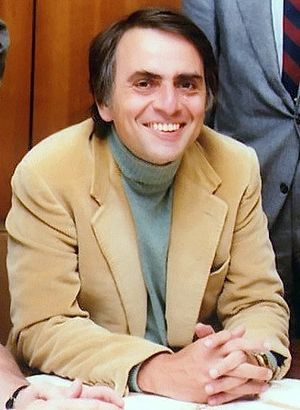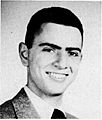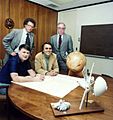Carl Sagan facts for kids
Quick facts for kids
Carl Sagan
|
|
|---|---|

Carl Sagan in 1980
|
|
| Born |
Carl Edward Sagan
November 9, 1934 Brooklyn, New York, U.S.
|
| Died | December 20, 1996 (aged 62) Seattle, Washington, U.S.
|
| Resting place | Ithaca, New York, U.S. |
| Nationality | American |
| Alma mater | University of Chicago |
| Known for |
|
| Spouse(s) |
Linda Salzman
(m. 1968; div. 1981)Ann Druyan
(m. 1981) |
| Children | 5, including Dorion and Nick |
| Awards | Klumpke-Roberts Award (1974) NASA Distinguished Public Service Medal (1977) Pulitzer Prize for General Non-Fiction (1978) Oersted Medal (1990) Carl Sagan Award for Public Understanding of Science (1993) National Academy of Sciences Public Welfare Medal (1994) |
| Scientific career | |
| Fields |
|
| Institutions | |
| Doctoral advisor | Gerard Kuiper |
| Doctoral students | Clark Chapman, James B. Pollack, Owen Toon |
Carl Edward Sagan (November 9, 1934 – December 20, 1996) was an American astronomer and science communicator. He was very good at explaining complex science ideas to everyone. He studied extraterrestrial life and showed how amino acids (building blocks of life) could form from simple chemicals.
Sagan created the first messages sent into space for possible alien life. These were the Pioneer plaque and the Voyager Golden Record. He also explained that the very hot surface of Venus is caused by the greenhouse effect.
Carl Sagan wrote over 600 scientific papers and more than 20 books. Some of his popular science books include The Dragons of Eden and Pale Blue Dot. He also hosted and co-wrote the famous 1980 TV series Cosmos: A Personal Voyage. This show was watched by millions of people worldwide. He also wrote the science fiction novel Contact, which was later made into a movie.
Sagan believed in asking questions and using the scientific method. He was a pioneer in exobiology (the study of life beyond Earth). He also promoted the Search for Extra-Terrestrial Intelligence (SETI). He spent most of his career teaching astronomy at Cornell University. Carl Sagan received many awards for his work, including the Pulitzer Prize for General Non-Fiction. He passed away at age 62 after battling a blood disease.
Contents
Early Life and Education
Carl Sagan was born in Brooklyn, New York City. His father, Sam Sagan, was a clothes maker, and his mother, Rachel Molly Gruber, was a housewife.
Sagan went to the University of Chicago. He earned two degrees in physics and later a doctorate in Astronomy in 1960. He taught at Harvard University before moving to Cornell University in 1968.
At Cornell, Sagan became a teacher and director in 1971. He helped with many unmanned spacecraft missions that explored outer space. He came up with the idea of putting messages on these spacecraft. These messages could be understood by any life from another planet that might find them. The first message was a gold-plated label on the Pioneer 10 space probe. He later helped create the Voyager Golden Record, sent with the Voyager space probes.
Amazing Discoveries and Ideas
Sagan was known for warning people about the dangers of nuclear winter. This is a theory about what would happen to Earth's climate after a large nuclear war.
He also helped us learn about other planets. He studied the atmosphere of Venus, seasonal changes on Mars, and Saturn's moon Titan. He showed that Venus has a very hot and thick atmosphere. He also said that global warming was a growing danger caused by humans. He compared it to how Venus became a hot and dangerous planet because of greenhouse gases. He suggested that the seasonal changes on Mars were caused by dust storms.
Sagan was one of the first to think that Titan and Jupiter's moon Europa might have oceans or lakes. This means that life could possibly exist there. Later, the Galileo spacecraft confirmed that Europa has an underground ocean.
Sagan strongly believed in searching for life on other planets. He thought scientists should use large radio telescopes to listen for signals from other planets. He also believed sending probes to other planets was a good idea. Sagan was the editor of Icarus, a magazine about space exploration, for 12 years. He helped start The Planetary Society and was a member of the SETI Institute Board of Trustees.
Spreading Science to Everyone
Carl Sagan was excellent at helping people understand the universe. He gave special Christmas Lectures for Young People at the Royal Institution in 1977 and 1978.
He co-wrote (with Ann Druyan, who became his third wife) and produced the very popular thirteen-part PBS television series Cosmos. He also wrote many books to make science popular, like The Dragons of Eden, which won a Pulitzer Prize. His novel, Contact, was a best-seller and was made into a film starring Jodie Foster in 1997. The film won the 1998 Hugo Award.
After Cosmos, Sagan became linked with the phrase "billions and billions," even though he never actually used it in the TV series (but he did often use the word "billions"). He wrote Pale Blue Dot: A Vision of the Human Future in Space, which was chosen as a notable book of 1995 by The New York Times.
While most scientists admired how he made science popular, some worried that people might confuse his personal opinions with scientific facts. For example, some of his predictions about the Kuwaiti oil fires during the first Gulf War turned out to be incorrect.
Later in his life, Sagan's books showed his skeptical and naturalistic view of the world.
Personal Life
Carl Sagan was married three times and had five children. He married biologist Lynn Margulis in 1957, and they had two children, Jeremy and Dorion Sagan. After their divorce, he married artist Linda Salzman in 1968, and they had one child, Nick Sagan. In 1981, Sagan married author Ann Druyan. They had two children, Alexandra (known as Sasha) and Samuel Sagan. Carl Sagan and Ann Druyan remained married until his death.
Legacy
Carl Sagan passed away on December 20, 1996, at the age of 62. He had been battling myelodysplasia, a blood disease, and died from pneumonia.
Sagan left a huge impact because he made science exciting and understandable for so many people. He also changed how science was organized and defended humanism.
The landing site of the unmanned Mars Pathfinder spacecraft was renamed the Carl Sagan Memorial Station in his honor on July 5, 1997. Asteroid 2709 Sagan is also named after him.
The 1997 movie Contact, based on Sagan's novel, was finished after his death. It ends with the dedication "For Carl."
Awards and Medals
- Apollo Achievement Award - National Aeronautics and Space Administration
- Distinguished Public Service - National Aeronautics and Space Administration
- Emmy - Outstanding individual achievement - 1981 - PBS series Cosmos
- Emmy - Outstanding Informational Series - 1981 - PBS series Cosmos
- Exceptional Scientific Achievement Medal - National Aeronautics and Space Administration
- Homer Award - 1997 - Contact
- Hugo Award - 1998 - Contact
- Hugo Award - 1981 - Cosmos
- Hugo Award - 1997 - The Demon-Haunted World
- In Praise of Reason Award - 1987 - Committee for the Scientific Investigation of Claims of the Paranormal
- Isaac Asimov Award - 1994 - Committee for the Scientific Investigation of Claims of the Paranormal
- John F. Kennedy Astronautics Award - American Astronautical Society
- John W. Campbell Memorial Award - 1974 - The Cosmic Connection
- Konstantin Tsiolkovsky Medal - Soviet Cosmonauts Federation
- Locus Poll Award 1986 - Contact
- Lowell Thomas Award - Explorers Club - 75th Anniversary
- Masursky Award - American Astronomical Society
- Peabody - 1980 - PBS series Cosmos
- Public Welfare Medal - 1994 - National Academy of Sciences
- Pulitzer Prize for Literature - 1978 - The Dragons of Eden
- SF Chronicle Award - 1998 - Contact
- Carl Sagan Memorial Award - Named in his honor
Images for kids
-
Sagan in University of Chicago's 1954 yearbook
-
The Planetary Society members at the organization's founding. Sagan is seated on the right.
-
Sagan (center) speaks with CDC employees in 1988.
-
Stone dedicated to Sagan in the Celebrity Path of the Brooklyn Botanic Garden
See also
 In Spanish: Carl Sagan para niños
In Spanish: Carl Sagan para niños










